Orpheus
| Orpheus | |
|---|---|
_-_Foto_G._Dall'Orto.jpg) Roman Orpheus mosaic, a very common subject. He wears a Phrygian cap and is surrounded by the animals charmed by lyre-playing | |
| Abode | Pimpleia, Pieria |
| Symbol | Lyre |
| Personal information | |
| Born | Pimpleia, Pieria |
| Died | Pangaion Hills, Macedonia, Greece |
| Spouse | Eurydice |
| Children | Musaeus |
| Parents | Oeagrus or Apollo and Calliope |
| Siblings | The Graces, Linus of Thrace |
| Greek mythology |
|---|
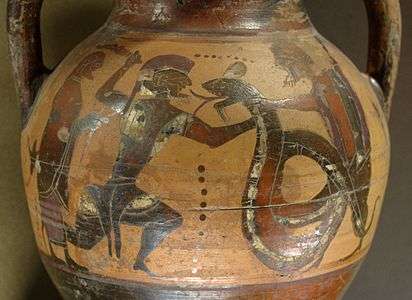 |
| Deities |
|
|
| Heroes and heroism |
|
| Related |
|
|
Orpheus (/ˈɔːrfiəs,
For the Greeks, Orpheus was a founder and prophet of the so-called "Orphic" mysteries.[3] He was credited with the composition of the Orphic Hymns and the Orphic Argonautica. Shrines containing purported relics of Orpheus were regarded as oracles.
Etymology
Several etymologies for the name Orpheus have been proposed. A probable suggestion is that it is derived from a hypothetical PIE root *h₃órbʰos "orphan, servant, slave" and ultimately the verb root *h₃erbʰ- "to change allegiance, status, ownership".[4] Cognates could include Greek ὄρφνη (órphnē) "darkness",[5] and surely Greek ὀρφανός (orphanós) "fatherless, orphan"[6], from which comes English "orphan" by way of Latin.
Fulgentius, a mythographer of the late 5th to early 6th century AD, gave the unlikely etymology meaning "best voice," "Oraia-phonos".[7]
Background
The earliest literary reference to Orpheus is a two-word fragment of the sixth-century BC lyric poet Ibycus: onomaklyton Orphēn ("Orpheus famous-of-name"). He is not mentioned in Homer or Hesiod.[8] Most ancient sources accept his historical existence; Aristotle is an exception.[9][10] Pindar calls Orpheus "the father of songs"[11] and identifies him as a son of the Thracian king Oeagrus[12] and the Muse Calliope.[13]
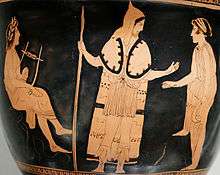
Greeks of the Classical age venerated Orpheus as the greatest of all poets and musicians; it was said that while Hermes had invented the lyre, Orpheus had perfected it. Poets such as Simonides of Ceos said that Orpheus' music and singing could charm the birds, fish and wild beasts, coax the trees and rocks into dance,[15] and divert the course of rivers. Orpheus was one of the handful of Greek heroes[16] to visit the Underworld and return; his music and song even had power over Hades.
Some sources credit Orpheus with further gifts to mankind: medicine, which is more usually under the auspices of Aesculapius or Apollo; writing,[17] which is usually credited to Cadmus; and agriculture, where Orpheus assumes the Eleusinian role of Triptolemus as giver of Demeter's knowledge to mankind. Orpheus was an augur and seer; he practiced magical arts and astrology, founded cults to Apollo and Dionysus[18] and prescribed the mystery rites preserved in Orphic texts. Pindar and Apollonius of Rhodes[19] place Orpheus as the harpist and companion of Jason and the Argonauts. Orpheus had a brother named Linus, who went to Thebes and became a Theban.[20] He is claimed by Aristophanes and Horace to have taught cannibals to subsist on fruit, and to have made lions and tigers obedient to him. Horace believed, however, that Orpheus had only introduced order and civilization to savages.[21]
Bertrand Russell noted:[22]
The Orphics were an ascetic sect; wine, to them, was only a symbol, as, later, in the Christian sacrament. The intoxication that they sought was that of "enthusiasm," of union with the god. They believed themselves, in this way, to acquire mystic knowledge not obtainable by ordinary means. This mystical element entered into Greek philosophy with Pythagoras, who was a reformer of Orphism as Orpheus was a reformer of the religion of Dionysus. From Pythagoras Orphic elements entered into the philosophy of Plato, and from Plato into most later philosophy that was in any degree religious.
Strabo (64 BC – c. AD 24) presents Orpheus as a mortal, who lived and died in a village close to Olympus.[23] "Some, of course, received him willingly, but others, since they suspected a plot and violence, combined against him and killed him." He made money as a musician and "wizard" – Strabo uses agurteúonta (αγυρτεύοντα),[24] also used by Sophocles in Oedipus Tyrannus to characterize Teiresias as a trickster with an excessive desire for possessions. Agúrtēs (αγύρτης) most often meant charlatan[25] and always had a negative connotation. Pausanias writes of an unnamed Egyptian who considered Orpheus a mágeuse (μάγευσε), i. e., magician.[26]
Mythology
Early life
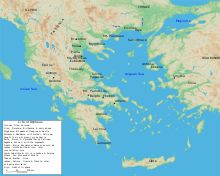
According to Apollodorus[27] and a fragment of Pindar,[28] Orpheus' father was Oeagrus, a Thracian king, or, according to another version of the story, the god Apollo. His mother was the muse Calliope or a daughter of Pierus,[29] son of Makednos. His birthplace and place of residence was in Pimpleia[30][31] close to the Olympus. Strabo mentions that he lived in Pimpleia.[23][31] According to the epic poem Argonautica, Pimpleia was the location of Oeagrus' and Calliope's wedding.[32] While living with his mother and her eight beautiful sisters in Parnassus, he met Apollo, who was courting the laughing muse Thalia. Apollo, as the god of music, gave Orpheus a golden lyre and taught him to play it.[33] Orpheus' mother taught him to make verses for singing. He is also said to have studied in Egypt.[34]
Orpheus is said to have established the worship of Hecate in Aegina.[35] In Laconia Orpheus is said to have brought the worship of Demeter Chthonia[36] and that of the Kóres Sōteíras (Greek Κόρες Σωτείρας "Saviour Maidens").[37] Also in Taygetus a wooden image of Orpheus was said to have been kept by Pelasgians in the sanctuary of the Eleusinian Demeter.[38]
According to Diodorus Siculus, Musaeus of Athens was the son of Orpheus.[39]
Travelling as an Argonaut
The Argonautica (Greek: Ἀργοναυτικά) is a Greek epic poem written by Apollonius Rhodius in the 3rd century BC. Orpheus took part in this adventure and used his skills to aid his companions. Chiron told Jason that without the aid of Orpheus, the Argonauts would never be able to pass the Sirens—the same Sirens encountered by Odysseus in Homer's epic poem the Odyssey. The Sirens lived on three small, rocky islands called Sirenum scopuli and sang beautiful songs that enticed sailors to come to them, which resulted in the crashing of their ships into the islands. When Orpheus heard their voices, he drew his lyre and played music that was louder and more beautiful, drowning out the Sirens' bewitching songs. According to 3rd century BC Hellenistic elegiac poet Phanocles, Orpheus loved the young Argonaut Calais, "the son of Boreas, with all his heart, and went often in shaded groves still singing of his desire, nor was his heart at rest. But always, sleepless cares wasted his spirits as he looked at fresh Calais."[40][41]
Death of Eurydice
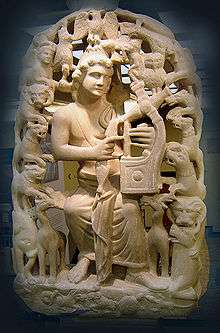
The most famous story in which Orpheus figures is that of his wife Eurydice (sometimes referred to as Euridice and also known as Argiope). While walking among her people, the Cicones, in tall grass at her wedding, Eurydice was set upon by a satyr. In her efforts to escape the satyr, Eurydice fell into a nest of vipers and suffered a fatal bite on her heel. Her body was discovered by Orpheus who, overcome with grief, played such sad and mournful songs that all the nymphs and gods wept. On their advice, Orpheus travelled to the underworld. His music softened the hearts of Hades and Persephone, who agreed to allow Eurydice to return with him to earth on one condition: he should walk in front of her and not look back until they both had reached the upper world. He set off with Eurydice following, and, in his anxiety, as soon as he reached the upper world, he turned to look at her, forgetting that both needed to be in the upper world, and she vanished for the second time, but now forever.
The story in this form belongs to the time of Virgil, who first introduces the name of Aristaeus (by the time of Virgil's Georgics, the myth has Aristaeus chasing Eurydice when she was bitten by a serpent) and the tragic outcome.[42] Other ancient writers, however, speak of Orpheus' visit to the underworld in a more negative light; according to Phaedrus in Plato's Symposium,[43] the infernal gods only "presented an apparition" of Eurydice to him. In fact, Plato's representation of Orpheus is that of a coward, as instead of choosing to die in order to be with the one he loved, he instead mocked the gods by trying to go to Hades to bring her back alive. Since his love was not "true"—he did not want to die for love—he was actually punished by the gods, first by giving him only the apparition of his former wife in the underworld, and then by being killed by women. In Ovid's account, however, Eurydice's death by a snake bite is incurred while she was dancing with naiads on her wedding day.
Virgil wrote in his poem that Dryads wept from Epirus and Hebrus up to the land of the Getae (north east Danube valley) and even describes him wandering into Hyperborea and Tanais (ancient Greek city in the Don river delta)[44] due to his grief.
The story of Eurydice may actually be a late addition to the Orpheus myths. In particular, the name Eurudike ("she whose justice extends widely") recalls cult-titles attached to Persephone. According to the theories of poet Robert Graves, the myth may have been derived from another Orpheus legend, in which he travels to Tartarus and charms the goddess Hecate.[45]
The myth theme of not looking back, an essential precaution in Jason's raising of chthonic Brimo Hekate under Medea's guidance,[46] is reflected in the Biblical story of Lot's wife when escaping from Sodom. More directly, the story of Orpheus is similar to the ancient Greek tales of Persephone captured by Hades and similar stories of Adonis captive in the underworld. However, the developed form of the Orpheus myth was entwined with the Orphic mystery cults and, later in Rome, with the development of Mithraism and the cult of Sol Invictus.
Death
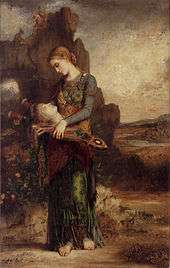

According to a Late Antique summary of Aeschylus' lost play Bassarids, Orpheus, towards the end of his life, disdained the worship of all gods except the sun, whom he called Apollo. One early morning he went to the oracle of Dionysus at Mount Pangaion[47] to salute his god at dawn, but was ripped to shreds by Thracian Maenads for not honoring his previous patron (Dionysus) and buried in Pieria.[18][48] Here his death is analogous with that of Pentheus, who was also torn to pieces by Maenads; and it has been speculated that the Orphic mystery cult regarded Orpheus as a parallel figure to or even an incarnation of Dionysus.[49] Both made similar journeys into Hades, and Dionysus Zagreus suffered an identical death.[50] Pausanias writes that Orpheus was buried in Dion and that he met his death there.[51] He writes that the river Helicon sank underground when the women that killed Orpheus tried to wash off their blood-stained hands in its waters.[52]
Ovid recounts that Orpheus ...
had abstained from the love of women, either because things ended badly for him, or because he had sworn to do so. Yet, many felt a desire to be joined with the poet, and many grieved at rejection. Indeed, he was the first of the Thracian people to transfer his affection to young boys and enjoy their brief springtime, and early flowering this side of manhood.
— Ovid. trans. A. S. Kline, Ovid: The Metamorphoses, Book X
Feeling spurned by Orpheus for taking only male lovers, the Ciconian women, followers of Dionysus,[53] first threw sticks and stones at him as he played, but his music was so beautiful even the rocks and branches refused to hit him. Enraged, the women tore him to pieces during the frenzy of their Bacchic orgies.[54] In Albrecht Dürer's drawing of Orpheus' death, based on an original, now lost, by Andrea Mantegna, a ribbon high in the tree above him is lettered Orfeus der erst puseran ("Orpheus, the first pederast").[55]
.jpg)
His head and lyre, still singing mournful songs, floated down the swift Hebrus to the Mediterranean shore. There, the winds and waves carried them on to the Lesbos shore,[56] where the inhabitants buried his head and a shrine was built in his honour near Antissa;[57] there his oracle prophesied, until it was silenced by Apollo.[58] In addition to the people of Lesbos, Greeks from Ionia and Aetolia consulted the oracle, and his reputation spread as far as Babylon.[59]

The lyre was carried to heaven by the Muses, and was placed among the stars. The Muses also gathered up the fragments of his body and buried them at Leibethra[60] below Mount Olympus, where the nightingales sang over his grave. After the river Sys flooded[61] Leibethra, the Macedonians took his bones to Dion. Orpheus' soul returned to the underworld where he was reunited at last with his beloved Eurydice.
Another legend places his tomb at Dion,[47] near Pydna in Macedon. In another version of the myth, Orpheus travels to Aornum in Thesprotia, Epirus to an old oracle for the dead. In the end Orpheus commits suicide from his grief unable to find Eurydice.[62]
Another account relates that he was struck with lightning by Zeus for having lied about the stories and the mysteries of the gods.
Orphic poems and rites

A number of Greek religious poems in hexameters were attributed to Orpheus, as they were to similar miracle-working figures, like Bakis, Musaeus, Abaris, Aristeas, Epimenides, and the Sibyl. Of this vast literature, only two works survived whole: the Orphic Hymns, a set of 87 poems, possibly composed at some point in the second or third century, and the epic poem Argonautica, composed somewhere between the fourth and sixth centuries. Earlier Orphic literature, which may date back as far as the sixth century BC, survives only in papyrus fragments or in quotations. Some of the earliest fragments may have been composed by Onomacritus.[63]
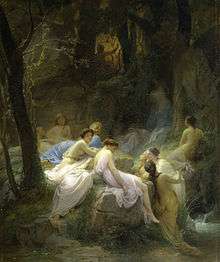
In addition to serving as a storehouse of mythological data along the lines of Hesiod's Theogony, Orphic poetry was recited in mystery-rites and purification rituals. Plato in particular tells of a class of vagrant beggar-priests who would go about offering purifications to the rich, a clatter of books by Orpheus and Musaeus in tow.[64] Those who were especially devoted to these rituals and poems often practiced vegetarianism and abstention from sex, and refrained from eating eggs and beans — which came to be known as the Orphikos bios, or "Orphic way of life".[65]
The Derveni papyrus, found in Derveni, Macedonia (Greece) in 1962, contains a philosophical treatise that is an allegorical commentary on an Orphic poem in hexameters, a theogony concerning the birth of the gods, produced in the circle of the philosopher Anaxagoras, written in the second half of the fifth century BC. Fragments of the poem are quoted making it "the most important new piece of evidence about Greek philosophy and religion to come to light since the Renaissance".[66] The papyrus dates to around 340 BC, during the reign of Philip II of Macedon, making it Europe's oldest surviving manuscript.
The historian William Mitford wrote in 1784 that the very earliest form of a higher and more cohesive ancient Greek religion was manifest in the Orphic poems.[67] W. K. C. Guthrie wrote that Orpheus was the founder of mystery religions and the first to reveal to men the meanings of the initiation rites.[68]
Post-Classical interpretations
Classical music
The Orpheus motif has permeated Western culture and has been used as a theme in all art forms. Early examples include the Breton lai Sir Orfeo from the early 13th century and musical interpretations like Jacapo Peri's Euridice (1600, though titled with his wife's name, the libretto is based entirely upon books X and XI of Ovid's Metamorphoses and therefore Orpheus' viewpoint is predominant). Subsequent operatic interpretations include Claudio Monteverdi's L'Orfeo (1607), Christoph Willibald Gluck's Orfeo ed Euridice (1762), Joseph Haydn's last opera L'anima del filosofo, ossia Orfeo ed Euridice (1791), Franz Liszt's symphonic poem Orpheus (1854), Igor Stravinsky's ballet Orpheus (1948) and two operas by Harrison Birtwistle: The Mask of Orpheus (1973–1984) and The Corridor (2009). The Bulgarian Rousse State Opera commissioned and performed Orpheus: A Masque by John Robertson. It debuted in 2015.[69]
Literature
Rainer Maria Rilke's Sonnets to Orpheus (1922) are based on the Orpheus myth. Poul Anderson's Hugo Award-winning novelette "Goat Song", published in 1972, is a retelling of the story of Orpheus in a science fiction setting. Some feminist interpretations of the myth give Eurydice greater weight. Margaret Atwood's Orpheus and Eurydice Cycle (1976–86) deals with the myth, and gives Eurydice a more prominent voice. Sarah Ruhl's Eurydice likewise presents the story of Orpheus' descent to the underworld from Eurydice's perspective. Ruhl removes Orpheus from the center of the story by pairing their romantic love with the paternal love of Eurydice's dead father.[70] David Almond's 2014 novel, A Song for Ella Grey, was inspired by the myth of Orpheus and Eurydice, and won the Guardian Children's Fiction Prize in 2015.[71] The 2014 novel Orfeo by Richard Powers is based on Orpheus.
Film and the graphic arts
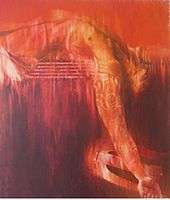
Vinicius de Moraes' play Orfeu da Conceição (1956), later adapted by Marcel Camus in the 1959 film Black Orpheus, tells the story in the modern context of a favela in Rio de Janeiro during Carnaval. Jean Cocteau's Orphic Trilogy – The Blood of a Poet (1930), Orpheus (1950) and Testament of Orpheus (1959) – was filmed over thirty years, and is based in many ways on the story. Philip Glass adapted the second film into the chamber opera Orphée (1991), part of a homage triptych to Cocteau. Nikos Nikolaidis' 1975 film Evrydiki BA 2O37 is an innovative perspective on the classic Greek tragedy of Orpheus and Eurydice.
Dino Buzzati adapted the Orpheus motif in his graphic novel Poem Strip (1969). Neil Gaiman depicts his version of Orpheus in The Sandman comics series (1989–2015). Gaiman's Orpheus is the son of Oneiros (the Dream Lord Morpheus) and the muse Calliope.[72]
Popular music
In August 1967 the UK rock band The Herd released a single whose A-side was a version of the Orpheus story written by Howard Blaikley called "From the Underworld" which reached No. 6 in the charts. Also The Incredible String Band's 1967 song "Blues for the Muse" (from the album The 5000 Spirits or the Layers of the Onion) mentions Orpheus in the lyric "But Orpheus made the sun rise 'cause he know how to play". The 13th studio album of the alternative rock band Nick Cave and the Bad Seeds is called Abattoir Blues / The Lyre of Orpheus (2004), with the initial song of the latter album based around a satirical reworking of the legend, viewed from a more modern male/female perspective. Folk artist Anaïs Mitchell's fourth studio album Hadestown (2010) is loosely based on the story of Orpheus and Eurydice set in modern times, and was remade into Hadestown, The Myth, The Musical in 2016. Peter Blegvad and Andy Partridge created a music and spoken-word recording, Orpheus the Lowdown. Composer Judge Smith based his songstory Orfeas (2011) on the ancient myth of Orpheus. Multi-instrumentalist Andrew Bird's song "Orpheo Looks Back" from his 2012 album Break It Yourself references the myth. In their 2013 album Reflektor, Arcade Fire allude to the tale of Orpheus and Eurydice in their songs "Awful Sound (Oh Eurydice)" and "It's Never Over (Hey Orpheus)". The album cover also depicts Auguste Rodin's sculpture of Orpheus and Eurydice.
Reception of the reception
Because of the pervasiveness of the Orpheus myth, many interpretations are in conversation with previous interpretations as well: Pina Bausch's dance-opera Orpheus und Euridike displays original choreography set to Gluck's Orfeo ed Euridice. Baz Luhrmann, in DVD commentaries for his 2001 film Moulin Rouge!, characterizes the film as, in part, a tale of an Orphic hero (in this case a songwriter) who embarks upon a visit to the underworld (in this case the demi-monde around Paris' Montmartre) in search of his fortune and ultimately to attempt the rescue of his doomed love. The film adapts a widely known piece from Jacques Offenbach's comedic operetta Orphée aux enfers (Orpheus in the Underworld), identified with the once-popular can-can music hall dance. Offenbach's operatic work had itself parodied the classical tale of Orpheus' attempted rescue of Eurydice from Pluto (Hades). Gavin Bryars' music for Édouard Lock's full length ballet Dido and Orfeo (2011) reworks music from the operas Dido and Aeneas (Purcell) and Orfeo ed Euridice (Gluck) for a small ensemble of saxophone, viola, cello and piano.
See also
Notes
- ↑ Fritz Graf and Sarah Iles Johnston, Ritual Texts for the Afterlife: Orpheus and the Bacchic Gold Tablets (Routledge, 2007), p. 167, while taking note of depictions in Greek art, particularly vase painting, that show Orpheus attired as a Greek, often in contrast to those in Thracian dress around him.
- ↑ Geoffrey Miles, Classical Mythology in English Literature: A Critical Anthology (Routledge, 1999), p. 54ff.
- ↑ Pausanias, Description of Greece, Corinth, 2.30.2
- ↑ Cf. "Ὀρφανός" in: Etymological Dictionary of Greek, ed. Robert S. P. Beekes (Ph. D. 1969). First published online October 2010. Consulted online on 03/05/2018.
- ↑ Cobb, Noel. Archetypal Imagination, Hudson, New York: Lindisfarne Press, p. 240. ISBN 0-940262-47-9
- ↑ Freiert, William K. (1991), Pozzi, Dora Carlisky; Wickersham, John M., eds., "Orpheus: A Fugue on the Polis", Myth and the Polis, Cornell University Press: 46, ISBN 0-8014-2473-9
- ↑ Miles, Geoffrey. Classical Mythology in English Literature: A Critical Anthology, London: Routledge, 1999, p. 57. ISBN 0-415-14755-7
- ↑ Ibycus, Fragments 17 (Diehl); M. Owen Lee, Virgil as Orpheus: A Study of the Georgics State University of New York Press, Albany (1996), p. 3.
- ↑ Kathleen Freeman, Ancilla to the Pre-Socratic Philosophers, Harvard University Press (1948), p. 1.
- ↑ Aristotle (1952). W. D. Ross; John Alexander Smith, eds. The Works of Aristotle. XII – Fragments. Oxford: Clarendon Press. p. 80.
- ↑ Pindar, Pythian Odes, 4.4.315
- ↑ Pindar fragment 126.9.
- ↑ Pseudo-Apollodorus, Bibliotheke 1.3.2, Argonautica 1.23, and the Orphic Hymn 24,12.
- ↑ "Attributed to the Painter of London E 497: Bell-krater (24.97.30) – Heilbrunn Timeline of Art History – The Metropolitan Museum of Art". metmuseum.org.
- ↑ Pseudo-Apollodorus, Bibliotheke 1.3.2; Euripides, Iphigeneia at Aulis, 1212 and The Bacchae, 562; Ovid, Metamorphoses 11: "with his songs, Orpheus, the bard of Thrace, allured the trees, the savage animals, and even the insensate rocks, to follow him>"
- ↑ Others to brave the nekyia were Odysseus, Theseus and Heracles; Perseus also overcame Medusa in a chthonic setting.
- ↑ A single literary epitaph, attributed to the sophist Alcidamas, credits Orpheus with the invention of writing. See Ivan Mortimer Linforth, "Two Notes on the Legend of Orpheus", Transactions and Proceedings of the American Philological Association 62, (1931):5–17).
- 1 2 Apollodorus (Pseudo Apollodorus), Library and Epitome, 1.3.2. "Orpheus also invented the mysteries of Dionysus, and having been torn in pieces by the Maenads he is buried in Pieria."
- ↑ Apollonius, Argonautica, passim.
- ↑ Apollodorus, Library and Epitome, 2.4.9, This Linus was a brother of Orpheus; he came to Thebes and became a Theban.
- ↑ William Godwin (1876). "Lives of the Necromancers". p. 44.
- ↑ Bertrand Russell (1947). History of Western Philosophy.
- 1 2 Strabo, Geography, Book 7, Chapter 7: "At the base of Olympus is a city Dium. And it has a village near by, Pimpleia. Here lived Orpheus, the Ciconian, it is said — a wizard who at first collected money from his music, together with his soothsaying and his celebration of the orgies connected with the mystic initiatory rites, but soon afterwards thought himself worthy of still greater things and procured for himself a throng of followers and power. Some, of course, received him willingly, but others, since they suspected a plot and violence, combined against him and killed him. And near here, also, is Leibethra."
- ↑ Gregory Nagy, Archaic Period (Greek Literature, Volume 2), ISBN 0-8153-3683-7, p. 46.
- ↑ Index in Eustathii commentarios in Homeri Iliadem et Odysseam by Matthaeus Devarius, p. 8.
- ↑ Pausanias, The Description of Greece, 6.20.18: "A man of Egypt said that Pelops received something from Amphion the Theban and buried it where is what they call Taraxippus, adding that it was the buried thing which frightened the mares of Oenomaus, as well as those of every charioteer since. This Egyptian thought that Amphion and the Thracian Orpheus were clever magicians, and that it was through their enchantments that the beasts came to Orpheus, and the stones came to Amphion for the building of the wall. The most probable of the stories in my opinion makes Taraxippus a surname of Horse Poseidon."
- ↑ Son of Oeagrus or Apollo and Calliope: Apollodorus 1.3.1.
- ↑ Pindar, frag. 126, line 9, noted in Kerényi 1959: 280.
- ↑ Son of the Muse Calliope or of a daughter of Pierus: Pausanias 9.30.4.
- ↑ William Keith Guthrie and L. Alderlink, Orpheus and Greek Religion (Mythos Books), 1993, ISBN 0-691-02499-5, p. 61 f.: "[…] is a city Dion. Near it is a village called Pimpleia. It was there they say that Orpheus the Kikonian lived."
- 1 2 Jane Ellen Harrison, Prolegomena to the Study of Greek Religion (Mythos Books), 1991, ISBN 0-691-01514-7, p. 469: "[…] near the city of Dium is a village called Pimpleia where Orpheus lived."
- ↑ The Argonautica, book I (ll. 23–34), "First then let us name Orpheus whom once Calliope bare, it is said, wedded to Thracian Oeagrus, near the Pimpleian height."
- ↑ Hoopes And Evslin, The Greek Gods, ISBN 0-590-44110-8, ISBN 0-590-44110-8, 1995, p. 77: "His father was a Thracian king; his mother the muse Calliope. For a while he lived on Parnassus with his mother and his eight beautiful aunts and there met Apollo who was courting the laughing muse Thalia. Apollo was taken with Orpheus, gave him his little golden lyre and taught him to play. And his mother taught him to make verses for singing."
- ↑ Diodorus Siculus, 4.25.2–4.
- ↑ Pausanias, Description of Greece, Corinth, 2.30.1 [2]: "Of the gods, the Aeginetans worship most Hecate, in whose honor every year they celebrate mystic rites which, they say, Orpheus the Thracian established among them. Within the enclosure is a temple; its wooden image is the work of Myron, and it has one face and one body. It was Alcamenes, in my opinion, who first made three images of Hecate attached to one another, a figure called by the Athenians Epipurgidia (on the Tower); it stands beside the temple of the Wingless Victory."
- ↑ Pausanias, Description of Greece, Laconia, 3.14.1,[5]: "[…] but the wooden image of Thetis is guarded in secret. The cult of Demeter Chthonia (of the Lower World) the Lacedaemonians say was handed on to them by Orpheus, but in my opinion it was because of the sanctuary in Hermione that the Lacedaemonians also began to worship Demeter Chthonia. The Spartans have also a sanctuary of Serapis, the newest sanctuary in the city, and one of Zeus surnamed Olympian."
- ↑ Pausanias, Description of Greece, Laconia, 3.13.1: "Opposite the Olympian Aphrodite the Lacedaemonians have a temple of the Saviour Maid. Some say that it was made by Orpheus the Thracian, others by Abairis when he had come from the Hyperboreans."
- ↑ Pausanias, Description of Greece, Laconia, 3.20.1,[5]: "Between Taletum and Euoras is a place they name Therae, where they say Leto from the Peaks of Taygetus […] is a sanctuary of Demeter surnamed Eleusinian. Here according to the Lacedaemonian story Heracles was hidden by Asclepius while he was being healed of a wound. In the sanctuary is a wooden image of Orpheus, a work, they say, of Pelasgians."
- ↑ Diodorus Siculus, 4.25.1–2.
- ↑ Katherine Crawford (2010). The Sexual Culture of the French Renaissance. Cambridge University Press. p. 28. ISBN 978-0-521-76989-1.
- ↑ John Block Friedman (2000-05-01). Orpheus in the Middle Ages. Syracuse University Press. p. 9. ISBN 978-0-8156-2825-5.
- ↑ M. Owen Lee, Virgil as Orpheus: A Study of the Georgics, State University of New York Press, Albany (1996), p. 9.
- ↑ Symposium 179d.
- ↑ "The Georgics of Virgil: Fourth Book". www.sacred-texts.com. Retrieved 11 July 2017.
- ↑ Robert Graves, The Greek Myths, Penguin Books Ltd., London (1955), Volume 1, Chapter 28, "Orpheus", p. 115.
- ↑ Apollonius of Rhodes, Argonautica, book III: "Let no footfall or barking of dogs cause you to turn around, lest you ruin everything", Medea warns Jason; after the dread rite, "The son of Aison was seized by fear, but even so he did not turn round..." (Richard Hunter, translator).
- 1 2 Orpheus and Greek Religion by William Keith Guthrie and L. Alderlink, ISBN 0-691-02499-5, p. 32
- ↑ Wilson, N., Encyclopedia of Ancient Greece, Routledge, 2013, ISBN 113678800X, p. 702: "His grave and cult belong not to Thrace but to Pierian Macedonia, northeast of Mount Olympus, a region that the Thracians had once inhabited
- ↑ Classical Mythology, p. 279, Mark P. O. Morford, Robert J. Lenardon.
- ↑ Harvard Studies in Classical Philology, volume 88, p. 211
- ↑ Pausanias, Description of Greece, Boeotia, 9.30.1. The Macedonians who dwell in the district below Mount Pieria and the city of Dium say that it was here that Orpheus met his end at the hands of the women. Going from Dium along the road to the mountain, and advancing twenty stades, you come to a pillar on the right surmounted by a stone urn, which according to the natives contains the bones of Orpheus.
- ↑ Pausanias, Description of Greece, Boeotia, 9.30.1. There is also a river called Helicon. After a course of seventy-five stades the stream hereupon disappears under the earth. After a gap of about twenty-two stades the water rises again, and under the name of Baphyra instead of Helicon flows into the sea as a navigable river. The people of Dium say that at first this river flowed on land throughout its course. But, they go on to say, the women who killed Orpheus wished to wash off in it the blood-stains, and thereat the river sank underground, so as not to lend its waters to cleanse manslaughter
- ↑ Patricia Jane Johnson (2008). Ovid Before Exile: Art and Punishment in the Metamorphoses. University of Wisconsin Press. p. 103. ISBN 978-0-299-22400-4. "by the Ciconian women."
- ↑ Ovid, trans. A. S. Kline (2000). Ovid: The Metamorphoses. Book XI.
- ↑ Heinrich Wölfflin (2013). Drawings of Albrecht Dürer. Courier Dover Publications. pp. 24–25. ISBN 978-0-486-14090-2.
- ↑ Carlos Parada "His head fell into the sea and was cast by the waves upon the island of Lesbos where the Lesbians buried it, and for having done this the Lesbians have the reputation of being skilled in music."
- ↑ Recently a cave was identified as the oracle of Orpheus nearby the modern village of Antissa; see Harissis H. V. et al. "The Spelios of Antissa; The oracle of Orpheus in Lesvos" Archaiologia kai Technes 2002; 83:68–73 (article in Greek with English abstract)
- ↑ Flavius Philostratus, Life of Apollonius of Tyana, 4.14.
- ↑ William Godwin (1876). "Lives of the Necromancers". p. 46.
- ↑ The Writing of Orpheus: Greek Myth in Cultural Context by Marcele Detienne, ISBN 0-8018-6954-4, p. 161
- ↑ Pausanias, Description of Greece, Boeotia, 9.30.1 [11] Immediately when night came the god sent heavy rain, and the river Sys (Boar), one of the torrents about Olympus, on this occasion threw down the walls of Libethra, overturning sanctuaries of gods and houses of men, and drowning the inhabitants and all the animals in the city. When Libethra was now a city of ruin, the Macedonians in Dium, according to my friend of Larisa, carried the bones of Orpheus to their own country.
- ↑ Others have said that his wife died before him, and that for her sake he came to Aornum in Thesprotis, where of old was an oracle of the dead. He thought, they say, that the soul of Eurydice followed him, but turning round he lost her, and committed suicide for grief. The Thracians say that such nightingales as nest on the grave of Orpheus sing more sweetly and louder than others.Pausanias, Description of Greece, Boeotia, 9.30.1.
- ↑ Freeman, Kathleen. Ancilla to the Pre-Socratic Philosophers, Harvard University Press (1948), p. 1.
- ↑ Plato. The Republic 364c–d.
- ↑ Moore, p. 56: "the use of eggs and beans was forbidden, for these articles were associated with the worship of the dead".
- ↑ Janko, Richard (2006). Tsantsanoglou, K.; Parássoglou, G.M.; Kouremenos, T., eds. "The Derveni Papyrus". Bryn Mawr Classical Review. Studi e testi per il 'Corpus dei papiri filosofici greci e latini'. Florence: Olschki. 13.
- ↑ Mitford, p. 89: "But the very early inhabitants of Greece had a religion far less degenerated from original purity. To this curious and interesting fact, abundant testimonies remain. They occur in those poems, of uncertain origin and uncertain date, but unquestionably of great antiquity, which are called the poems of Orpheus or rather the Orphic poems [Note: Particularly in the Hymn to Jupiter, quoted by Aristotle in the seventh chapter of his Treatise on the World]; and they are found scattered among the writings of the philosophers and historians." The idea of a religion "degenerated from original purity" expressed an Enlightenment idealisation of an assumed primitive state that is one connotation of "primitivism" in the history of ideas.
- ↑ Guthrie, pp. 17–18. "As founder of mystery-religions, Orpheus was first to reveal to men the meaning of the rites of initiation (teletai). We read of this in both Plato and Aristophanes (Aristophanes, Frogs, 1032; Plato, Republic, 364e, a passage which suggests that literary authority was made to take the responsibility for the rites)". Guthrie goes on to write about "This less worthy but certainly popular side of Orphism is represented for us again by the charms or incantations of Orpheus which we may also read of as early as the fifth century. Our authority is Euripides. We have already noticed the 'charm on the Thracian tablets' in the Alcestis and in Cyclops one of the lazy and frightened Satyrs, unwilling to help Odysseus in the task of driving the burning stake into the single eye of the giant, exclaims: 'But I know a spell of Orpheus, a fine one, which will make the brand step up of its own accord to burn this one-eyed son of Earth' (Euripides, Cyclops 646 = Kern, test. 83)."
- ↑ Rousse State Opera. "Световна премиера на операта „Орфей” от канадския композитор Джон Робъртсън в МФ „Сцена край реката”-Русе" ("World Premiere of the opera "Orpheus" by Canadian composer John Robertson"). Retrieved 22 February 2016 (in Bulgarian).
- ↑ Isherwood, Charles (2007-06-19). "The Power of Memory to Triumph Over Death". New York Times.
- ↑ https://www.theguardian.com/childrens-books-site/2015/nov/19/david-almond-wins-guardian-childrens-fiction-prize
- ↑ Gaiman, Neil. The Sandman #50.
Bibliography
- Pseudo-Apollodorus, Bibliotheke I, iii, 2; ix, 16 & 25;
- Apollonius Rhodius, Argonautica I, 23–34; IV, 891–909.
- Bernabé, Albertus (ed.), Orphicorum et Orphicis similium testimonia et fragmenta. Poetae Epici Graeci. Pars II. Fasc. 1. Bibliotheca Teubneriana, München/Leipzig: K.G. Saur, 2004. ISBN 3-598-71707-5. review of this book
- Guthrie, William Keith Chambers, Orpheus and Greek Religion: a Study of the Orphic Movement, 1935.
- Kerenyi, Karl (1959). The Heroes of the Greeks. New York/London: Thames and Hudson.
- Mitford, William, The History of Greece, 1784. Cf. v.1, Chapter II, Religion of the Early Greeks.
- Moore, Clifford H., Religious Thought of the Greeks, 1916. Kessinger Publishing (April 2003). ISBN 978-0-7661-5130-7
- Ossoli, Margaret Fuller, Orpheus, a sonnet about his trip to the underworld.
- Ovid, Metamorphoses X, 1–105; XI, 1–66;
- Christoph Riedweg, "Orfeo", in: S. Settis (a cura di), I Greci: Storia Cultura Arte Società, volume II, 1, Turin 1996, 1251–1280.
- Christoph Riedweg, "Orpheus oder die Magie der musiké. Antike Variationen eines einflussreichen Mythos", in: Th. Fuhrer / P. Michel / P. Stotz (Hgg.), Geschichten und ihre Geschichte, Basel 2004, 37–66.
- Rohde, Erwin, Psyche, 1925. cf. Chapter 10, The Orphics.
- Segal, Charles (1989). Orpheus : The Myth of the Poet. Baltimore: Johns Hopkins University Press. ISBN 0-8018-3708-1.
- Smith, William; Dictionary of Greek and Roman Biography and Mythology, London (1873). "Orpheus"
- Taylor, Thomas [translator], The Mystical Hymns of Orpheus, 1896.
- West, Martin L., The Orphic Poems, 1983. There is a sub-thesis in this work that early Greek religion was heavily influenced by Central Asian shamanistic practices. One major point of contact was the ancient Crimean city of Olbia.
- Wise, R. Todd, A Neocomparative Examination of the Orpheus Myth As Found in the Native American and European Traditions, 1998. UMI. The thesis explores Orpheus as a single mythic structure present in traditions that extend from antiquity to contemporary times and across cultural contexts.
- Wroe, Ann, Orpheus: The Song of Life, The Overlook Press, New York, 2012.
External links
| Wikimedia Commons has media related to Orpheus. |
| Greek Wikisource has original text related to this article: |
| Wikiquote has quotations related to: Orpheus |
- Greek Mythology Link, Orpheus
- Theoi Project: online text: The Orphic Hymns translated by Thomas Taylor
- The Life and Theology of Orpheus by Thomas Taylor, including several Orphic Hymns and their accompanying notes by Taylor
- Orphica in English and Greek (select resources)
- Leibethra – The Tomb of Orpheus (in Greek)
- Warburg Institute Iconographic Database (ca. 400 images of Orpheus)
- Greek Myth Comix: The Story of Orpheus A detailed comic-strip retelling of Orpheus by Greek Myth Comix
- Orphicorum fragmenta, Otto Kern (ed.), Berolini apud Weidmannos, 1922.